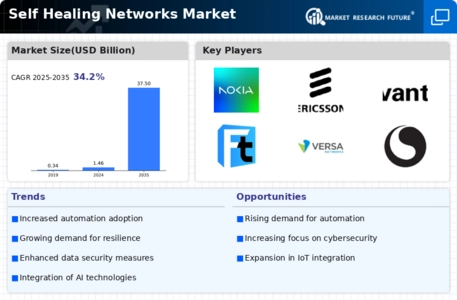Top Industry Leaders in the Self Healing Networks Market

Self-Healing Networks Market: Competitive Landscape
Market on the Rise: The self-healing networks market is experiencing a surge, projected to reach a staggering Value by 2027. This growth is driven by factors like an increasingly complex IT landscape, rising security threats, and the relentless demand for network uptime and efficiency. Navigating this dynamic terrain requires a close look at the key players, their strategies, and the evolving trends shaping the competitive landscape.
Key Players :
-
Nokia
-
Ericsson
-
Ivanti
-
Fortra LLC
-
Versa Networks, Inc.
-
IBM Corporation
-
Cisco Systems, Inc.
-
VMware, Inc.
-
CommScope
-
Appnomic
Factors for Market Share Analysis:
-
Portfolio Breadth and Depth: The range of self-healing functionalities, network management tools, and security features offered within a company's portfolio significantly impacts market share.
-
Technological Innovation: Continuous investment in R&D, integration of advanced AI algorithms for anomaly detection and predictive maintenance, and adoption of open-source platforms attract customer interest.
-
Target Market Focus: Companies that effectively cater to specific industry verticals or network deployment models (datacenters, cloud, hybrid) gain competitive advantage.
-
Pricing Strategies and Value Proposition: Offering flexible pricing models, tiered subscriptions, and bundled services like maintenance and support can win over cost-sensitive customers.
-
Partnerships and Acquisitions: Strategic collaborations with technology vendors, service providers, and system integrators expand reach and expertise, while acquisitions can fast-track entry into new segments or geographies.
Current Investment Trends:
-
Artificial Intelligence (AI) & Machine Learning (ML): Increased investment in AI-powered self-healing capabilities, including anomaly detection, automated remediation, and predictive maintenance, drives market growth.
-
Cloud-Based Solutions: The demand for scalable, cost-effective self-healing solutions fuels investments in cloud-based platforms and software-as-a-service (SaaS) models.
-
Cybersecurity Integration: Growing concerns about cyber threats encourage integration of security features like intrusion detection and prevention into self-healing network platforms.
-
Simplified Automation & Orchestration: Investments in user-friendly dashboards, intuitive network management tools, and automated configuration workflows address the need for simplified operational control.
-
Interoperability and Open Standards: Support for open standards and interoperability with diverse network equipment enhances flexibility and facilitates integration with existing infrastructure.
A Look Ahead: The self-healing networks market is poised for continued expansion, with opportunities for both established players and innovative newcomers. Understanding the competitive landscape, key players' strategies, and emerging trends will be crucial for navigating this dynamic market and carving out a successful path.
Latest Company Updates:
1. Juniper Networks Unveils AI-Powered "Mist Self-Healing Platform" Expansion (Dec 21, 2023, Juniper Networks press release): Juniper broadens its Mist portfolio with new capabilities for AI-driven network anomaly detection, proactive remediation, and enhanced security. This move strengthens their position in the enterprise self-healing network space.
2. OPNFV Announces Collaboration with AT&T for Open-Source Self-Healing Network Deployment (Jan 2, 2024, Light Reading): OPNFV partners with AT&T to deploy an open-source self-healing network platform for its 5G network infrastructure. This collaboration highlights the growing adoption of open-source solutions in the market.
3. IBM and VMware Join Forces to Develop Integrated Self-Healing Network Management Platform (Dec 19, 2023, ITWeb): IBM and VMware announce a strategic partnership to develop a unified self-healing network management platform for hybrid cloud environments. This collaboration targets enterprise clients seeking seamless network management across diverse infrastructure.

